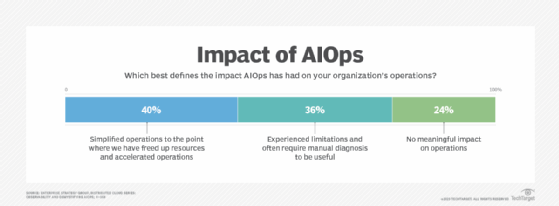Why AIOps will look at generative AI tools to grow adoption
AIOps generally sees limited results in its current implementations, but generative AI can potentially help expand and monetize these processes for organizations.
TechTarget reader data shows that interest in generative AI is at an all-time high, with content on the topic up 160% year-over-year and up 60% in the last quarter.
Along with the piqued interest, expectations are also high that this new crop of generative AI will have a significant effect on IT operations. All my conversations over the past months with IT leaders and vendors have included speculation on how AI will play a role in IT operations.
The current situation
In the latest research from TechTarget's Enterprise Strategy Group, "Distributed Cloud Series: Observability and Demystifying AIOps," we found that 55% of organizations with observability practices use AIOps, but the results they currently receive have been decidedly mixed. Some of the reasons for these mixed results include poor data quality, lackluster or incomplete model training and a lack of integration with other infrastructure management tools.
The same study also revealed that just 40% of AIOps tool users report that AIOps has simplified operations to the point where they have freed up resources and accelerated operations. The other 60% found that they experienced limitations, needed to manually intervene or that their AIOps investments had yet to have a meaningful bearing on IT operations.

In its current state, generative AI tools have the potential to significantly increase the value and effectiveness of AIOps platforms by delivering anomaly detection, root cause analysis and automated remediation.
But there's always room to grow with generative AI in AIOps.
Experimental progress
The AIOps platform provider Big Panda recently published the results of two interesting experiments. In the first experiment, they used generative AI from OpenAI, Amazon and Google to determine how well large language models could translate a series of 20-plus correlated alerts from monitoring sources and technology stacks including DataDog, Grafana, AppDynamics and Splunk across network, database, infrastructure and application monitoring.
Big Panda found that simply taking the alerts from those sources and throwing them at the large language model (LLM) did not produce accurate insights. As a result, IT teams would have wasted precious time chasing the wrong root cause of a problem.
The second experiment was the same as the first, but it included more contextual data, such as CMDB recent changes, lists of impacted users and applications, service maps and trace information. With richer data, this experiment saw all three generative AI models correctly identify the "needle in the haystack" root cause of the failure amongst the 20-plus alerts that were initially fed to the system.
The study concluded that, given good and extensive data, generative AI trained on LLMs can accurately identify and summarize the incident, impact and root cause. Big Panda noted that simply generating a summary of an incident can take an Ops staffer five minutes and relies heavily on their experience and domain expertise.
However, if these tools can save five minutes, it allows for five minutes for faster incident triage, combined with more accurate root cause analysis and higher incident resolution. When this is multiplied over hundreds or thousands of incidents, the improvement in MTTD and MTTR could be significant.
Notably, what Big Panda and others are doing is to use generative AI to increase the speed and accuracy of IT problem-solving. While in the early stages today, I expect that we will see the needle move within organizations that may be skeptical or that had suboptimal experiences with earlier technology. My advice is to pay close attention to what your IT operations tool vendors are announcing and try to get your hands a little dirty with some of their newest offerings.
Enterprise Strategy Group is a division of TechTarget. Its analysts have business relationships with technology vendors.







